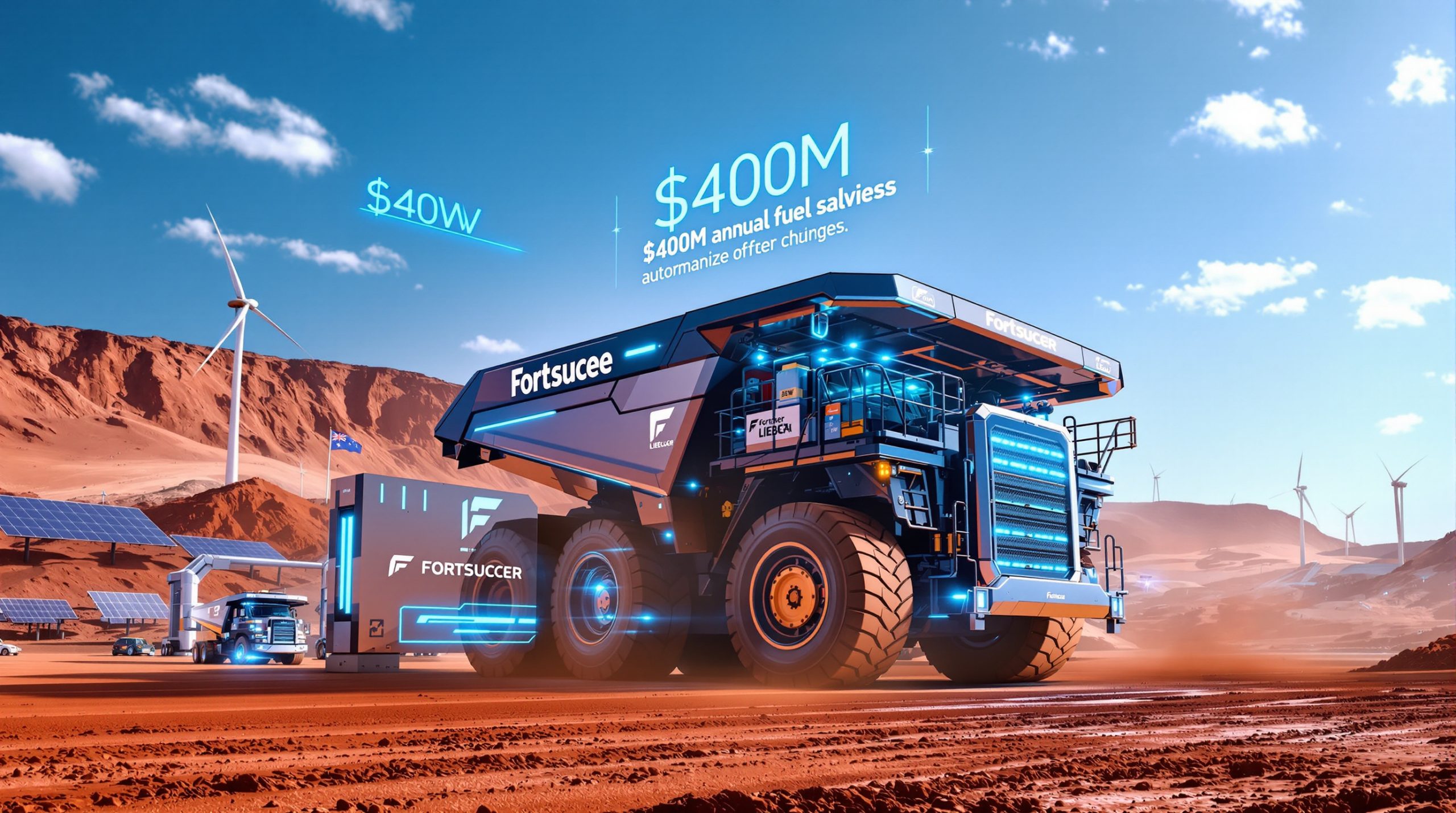Australia's Critical Minerals Strategy: Securing the Future of Global Supply Chains
Australia's pivotal role in the global critical minerals landscape is increasingly significant as nations worldwide seek to secure supply chains essential for technological advancement and energy transition. The country's comprehensive Australia critical minerals strategy aims to leverage its vast geological resources while navigating complex geopolitical dynamics and market challenges.
What Are Critical Minerals and Why Do They Matter?
Critical minerals have transformed from mere technical components into powerful geopolitical assets reshaping international relations and industrial strategies. These resources—including lithium, rare earths, graphite, and cobalt—form the foundation of modern technologies and the clean energy revolution.
Countries with secure critical minerals energy security demonstrate significantly stronger industrial resilience, with economic security indicators showing 15-20% greater resilience against supply disruptions. This advantage translates directly to national security, as critical minerals support essential defense technologies from advanced weapons systems to sophisticated communications equipment.
The energy transition has dramatically increased mineral intensity in technology manufacturing. Clean energy technologies require up to six times more minerals than their conventional counterparts, creating unprecedented demand pressure on global supply chains. This demand surge makes secure access to these resources not just an economic advantage but a strategic necessity.
The Strategic Value Beyond Resources
Critical minerals represent more than raw materials—they embody strategic leverage in international relations. Nations controlling these resources gain significant influence over technological development pathways and energy transition timelines globally.
The defense sector particularly depends on specific minerals for advanced capabilities, including gallium for radar systems, rare earths for precision-guided munitions, and specialized metals for aerospace applications. Military readiness increasingly correlates with mineral supply security.
Energy independence, once defined by fossil fuel self-sufficiency, now encompasses critical mineral supply chains. Countries leading in renewable energy deployment face new dependencies on mineral inputs, creating complex security calculations for policymakers.
Global Supply Chain Vulnerabilities
The current critical minerals landscape features alarming concentration risks. Processing capacity for many minerals remains heavily centralized, creating significant bottlenecks and strategic vulnerabilities. Historical precedents have demonstrated how supply restrictions can trigger price volatilities exceeding 300%, destabilizing downstream industries.
Transportation risks further complicate supply security, with shipping disruptions potentially isolating dependent nations from vital resources. The capital-intensive nature of developing alternative supply chains also creates barriers to rapid diversification, maintaining dependency relationships even when recognized as problematic.
How is China Dominating the Critical Minerals Landscape?
China has methodically built dominant positions across the critical minerals value chain through decades of strategic investment and policy coordination. This dominance extends far beyond raw material extraction to encompass processing, refining, and manufacturing capabilities.
China's approach to critical minerals reflects a long-term strategic vision linking resource security to technological leadership and geopolitical influence. Through careful coordination of state-owned enterprises, private companies, and government policy, Beijing has established control over key supply chains that would take competitor nations years or decades to replicate.
The processing sector shows China's most decisive advantage, controlling over 85% of global rare earth processing and similarly dominant positions in graphite, lithium hydroxide, and other essential materials. This midstream dominance creates leverage even over countries with significant mining operations, as raw materials must still pass through Chinese facilities.
China's Strategic Mineral Control
China's systematic approach involves vertical integration strategies connecting mining operations to processing facilities and manufacturing centers. This integration creates efficiencies difficult for competitors to match and allows flexibility in responding to market changes.
African investments have become a cornerstone of China's critical mineral strategy, securing access to approximately 70% of global cobalt production through strategic partnerships and direct investments. These relationships extend beyond simple resource extraction to include infrastructure development and political influence.
Perhaps most concerning to Western nations is China's demonstrated willingness to use its supply chain position as a geopolitical tool. Export restrictions have been employed selectively to pressure other countries, establishing critical minerals as instruments of foreign policy rather than merely commercial commodities.
Western Response Challenges
Democratic nations face significant obstacles in developing competitive alternatives to Chinese supply chains. Fragmented policy approaches across allied countries reduce effectiveness, with different regulatory frameworks, subsidy programs, and strategic priorities often working at cross-purposes.
The timeline asymmetry presents another challenge, as China's decades-long development of critical mineral capabilities cannot be matched quickly. New processing facilities typically require 5-7 years from planning to full operation, creating a significant lag in response capacity.
Capital intensity creates further barriers, with commercial-scale processing facilities often requiring investments exceeding $500 million. These costs, combined with technology risks and market uncertainties, make private financing difficult without substantial government support.
What is Australia's Critical Minerals Strategy 2023-2030?
Australia's Critical Minerals Strategy represents a comprehensive approach to positioning the country as a global leader in responsible mineral supply while building domestic capabilities across the value chain. The strategy addresses both immediate market opportunities and long-term strategic objectives.
The 2023-2030 timeframe reflects recognition that supply chain transformation requires sustained commitment beyond political cycles. This longer horizon enables consistent policy signals to investors and international partners while acknowledging the development timelines inherent in major resource projects.
Australia's approach balances economic objectives with strategic imperatives, recognizing that critical minerals represent both commercial opportunities and national security assets. This dual focus shapes investment priorities, regulatory approaches, and international partnerships.
Core Strategic Pillars
Australia's strategy emphasizes supply chain diversification through partnerships with democratic allies, reducing concentration risks while building resilient networks aligned with shared values. This approach acknowledges that no single country can secure all aspects of critical mineral supply chains independently.
Domestic processing development forms another central pillar, aiming to capture more value onshore while reducing vulnerability to foreign processing bottlenecks. Australia's strategy targets specific segments where it holds competitive advantages rather than attempting to replicate entire supply chains.
The integration of renewable energy with mineral production creates a virtuous cycle supporting both sectors. Australia's abundant solar and wind resources provide opportunities to develop "green premium" minerals with lower carbon footprints, appealing to environmentally conscious markets.
Regional development focus ensures benefits extend beyond metropolitan centers to communities directly impacted by resource development. This approach aims to build broader political support while addressing workforce and infrastructure challenges in remote areas.
Key Implementation Mechanisms
The Critical Minerals Task Force coordinates a whole-of-government approach, reducing bureaucratic barriers and aligning regulatory frameworks with strategic objectives. This coordination helps streamline approvals while maintaining environmental and social standards.
Financial support mechanisms include the $2 billion Critical Minerals Facility, providing targeted financing for projects facing market gaps. This facility emphasizes projects with strategic value that might not secure commercial financing based on purely financial metrics.
The $1.2 billion critical minerals reserve represents an innovative approach, providing offtake guarantees and selective stockpiling to reduce market risks for producers. This mechanism helps projects secure financing by addressing uncertainty about future demand.
Regulatory streamlining initiatives aim to reduce approval timeframes by up to 40% without compromising standards. This acceleration recognizes the time-sensitive nature of critical mineral opportunities in a rapidly evolving global landscape.
How Does Australia's Geological Advantage Translate to Strategic Opportunity?
Australia's exceptional mineral endowment provides the foundation for its critical minerals ambitions. The country hosts world-class deposits across multiple commodities essential to future technologies, creating opportunities to leverage geological advantages into strategic positioning.
The country's lithium resources rank among the world's largest, with high-grade spodumene deposits in Western Australia offering competitive advantages in quality and concentration. These resources can potentially supply approximately 30% of global demand, establishing Australia as an essential supplier for battery technologies.
Rare earth deposits containing all 17 rare earth elements, including the more valuable heavy rare earths, position Australia as one of few democratic nations with comprehensive rare earth potential. These resources offer alternatives to Chinese supply dominance in this crucial sector.
Australia's Resource Potential
Australia's graphite resources remain largely undeveloped despite significant potential, particularly in high-grade flake deposits suitable for battery anode materials. Development of these resources could address a key supply chain vulnerability for Western nations.
Nickel and cobalt deposits support battery supply chains with ethical sourcing advantages, particularly compared to supply from regions with documented human rights concerns. Australia's strong governance and regulatory frameworks provide assurance to manufacturers increasingly focused on responsible sourcing.
Beyond traditional critical minerals, Australia also possesses significant resources of emerging materials like vanadium and high-purity alumina. These minerals support advanced energy storage technologies and specialized electronics, broadening Australia's critical mineral portfolio.
Regional Resource Distribution
Western Australia dominates the country's lithium and rare earth potential, hosting world-class operations in the Pilbara and Goldfields regions. The state's established mining infrastructure and expertise provide advantages for rapid development of new projects.
Queensland hosts significant copper, cobalt, and vanadium resources, particularly in the state's northwest mineral province. These deposits benefit from proximity to port facilities and established mining communities with relevant skills.
The Northern Territory represents an emerging critical mineral frontier with substantial rare earth potential in several prospective regions. Development in this territory faces infrastructure challenges but offers significant capacity expansion opportunities.
South Australia continues developing graphite and rare earth opportunities, with several advanced projects moving toward production decisions. The state's supportive regulatory environment has attracted investment in processing technologies as well as extraction.
What Challenges Does Australia Face in Implementing Its Strategy?
Despite its geological advantages, Australia confronts significant challenges in translating mineral potential into strategic leverage. These obstacles span economic, technical, and policy dimensions, requiring coordinated responses across government and industry.
The financial viability of critical mineral projects faces pressure from market volatility driven by dominant suppliers. Price fluctuations of up to 60% in certain minerals create investment uncertainty and challenge project economics, particularly for smaller developers without diversified operations.
Australia's geographic distance from major manufacturing centers increases logistics costs and complexities compared to competitors. This disadvantage particularly affects lower-value minerals where transportation represents a higher percentage of delivered costs.
Economic and Market Challenges
Capital intensity requirements for processing facilities present major barriers, with commercial-scale operations often requiring investments exceeding $500 million. This scale of investment demands patient capital and risk tolerance that pure commercial financiers rarely provide without government support.
Chinese market flooding tactics have repeatedly disrupted market development, with strategic oversupply creating price volatility that undermines competitor project economics. This pattern has affected multiple minerals, including rare earths, graphite, and more recently, lithium.
Technology risk factors in processing novel mineral deposits add complexity to project development. Unproven process flows or challenging mineralogy can increase costs and delay commercialization, requiring specialized expertise often in limited supply globally.
Offtake security concerns persist with limited non-Chinese buyers for some minerals, creating dependency on potentially competing markets. This challenge particularly affects minerals where manufacturing remains concentrated in China, creating potential conflicts of interest for buyers.
Domestic Implementation Barriers
Approval timeframes stretching 3-5 years for major projects create significant delays compared to international competitors. These extended timelines reflect Australia's robust environmental and social impact assessment processes, which while important, can disadvantage projects in fast-moving markets.
Skills shortages in specialized processing technologies limit Australia's ability to rapidly develop downstream capabilities. The technical expertise required for complex chemical processing facilities often requires international recruitment or extensive training programs.
Energy cost disadvantages compared to international competitors impact processing economics, particularly for energy-intensive operations like rare earth separation or lithium hydroxide production. Australia's traditionally high energy costs offset some of its geological advantages.
Infrastructure gaps in remote regions where deposits are located create additional development costs. Many promising critical mineral resources exist in areas lacking sufficient power, water, and transportation infrastructure, requiring significant upfront investment.
How Is Australia Building International Partnerships for Critical Minerals?
Recognizing that critical mineral supply chains require international cooperation, Australia has prioritized strategic partnerships with like-minded nations. These relationships aim to create resilient, diversified supply networks aligned with democratic values and mutual interests.
The partnership approach acknowledges that different countries bring complementary strengths to critical mineral supply chains. Australia's resource advantages combine with processing technologies from Japan, manufacturing scale from the United States, and market access in Europe to create more competitive alternatives to Chinese dominance.
These collaborations extend beyond government-to-government agreements to include industry partnerships, research cooperation, and investment relationships. This multi-layered approach builds deeper connections less vulnerable to political changes.
Strategic Partnership Framework
The US-Australia Critical Minerals Partnership provides financing and offtake support for strategic projects, leveraging both countries' resources to accelerate development. This relationship has expanded beyond diplomatic dialogues to include concrete financial commitments and commercial arrangements.
The Quad Critical Minerals Network aligns Australia, the US, Japan, and India in coordinating critical mineral strategies across the Indo-Pacific region. This multilateral approach combines diplomatic influence with technical cooperation and market development initiatives.
The EU-Australia Critical Minerals Agreement opens European markets to Australian suppliers while providing technical exchange on processing technologies and environmental standards. This relationship connects Australia's resources with Europe's manufacturing ambitions in clean energy and electric vehicles.
UK-Australia collaboration on processing technologies and financing supports innovation in mineral processing while providing additional capital sources for project development. This partnership leverages the UK's financial expertise and Australia's resources for mutual benefit.
Practical Cooperation Mechanisms
Joint technology development initiatives focus on processing innovations that can reduce costs or improve environmental performance. These collaborations connect Australian resources with international expertise in chemical engineering and materials science.
Co-financing arrangements for strategic projects reduce capital risks by combining resources from multiple government agencies and private investors. These structures help overcome the financing barriers that often delay critical mineral developments.
Information sharing platforms enhance supply chain transparency, reducing information asymmetries that can disadvantage new market entrants. These systems provide better visibility into market developments, technical challenges, and regulatory changes affecting the sector.
Regulatory alignment efforts streamline cross-border investments by harmonizing requirements and reducing compliance burdens. This coordination particularly benefits projects seeking capital from multiple jurisdictions or serving international markets.
What Role Does the "Future Made in Australia" Policy Play?
The Australian government has positioned critical minerals as a cornerstone of its broader "Future Made in Australia" policy, which aims to rebuild domestic manufacturing capabilities by leveraging the country's resource advantages. This integration connects mineral development to broader economic objectives.
This policy explicitly links Australia's critical mineral strategy to domestic manufacturing revival, creating a coherent narrative around economic transformation. The approach recognizes that mineral resources create more value when connected to downstream processing and manufacturing capabilities.
The policy framework emphasizes creating complete value chains within Australia rather than simply exporting raw materials. This vertical integration ambition represents a significant shift from Australia's historical position primarily as a resource exporter.
Integration with National Manufacturing Priorities
Battery manufacturing initiatives connect mineral production directly to energy storage opportunities, targeting domestic production of battery cells and packs rather than only precursor materials. These initiatives aim to capture more value from Australia's lithium, nickel, and graphite resources.
Renewable technology supply chains utilizing domestic critical minerals create synergies between resource development and clean energy manufacturing. Australia's solar and wind resources complement its mineral endowment, creating opportunities for integrated development.
Defense industry applications ensure sovereign capabilities in strategic technologies, reducing vulnerability to supply disruptions in critical systems. This integration addresses national security concerns while creating stable demand for specialized materials.
Advanced materials development creates high-value products from raw materials, focusing on specialized compounds and engineered materials rather than commodity outputs. This approach targets higher-margin segments less vulnerable to price competition.
Investment Attraction Mechanisms
Tax incentives for downstream processing facilities reduce effective costs for investors while creating stronger business cases for locating operations in Australia. These incentives aim to offset some of the higher operating costs compared to international competitors.
Co-investment models reduce capital risks by providing government equity alongside private investment, particularly for first-of-kind facilities facing technology or market uncertainties. This approach shares risk while maintaining commercial discipline.
Research and development support for processing innovations helps overcome technical barriers to commercialization. This support includes funding for pilot plants, demonstration facilities, and process optimization research.
Skills development programs build workforce capabilities needed for advanced manufacturing and processing operations. These initiatives include specialized training programs, university partnerships, and international knowledge transfer arrangements.
How Are ASX-Listed Companies Positioned in the Critical Minerals Space?
The Australian Securities Exchange hosts numerous companies across the critical minerals value chain, though their performance reflects the challenges and opportunities inherent in this emerging sector. The market includes diverse participants from global diversified miners to specialized technology developers.
Investor interest in critical minerals has fluctuated significantly, driven by commodity price cycles, policy announcements, and changing perceptions of supply chain risks. This volatility creates challenges for companies requiring patient capital for long-term development projects.
The performance divergence between different segments of the critical minerals market highlights the importance of strategic positioning. Companies with secured offtake agreements, processing capabilities, or unique resource advantages have generally demonstrated greater resilience against market volatility.
Company Positioning Analysis
Major resource sector players (including BHP, Rio Tinto, Mineral Resources, and South32) have incorporated critical minerals into their diversified portfolios, providing financial stability while developing specialized capabilities. These companies leverage existing operations and balance sheet strength to manage market volatility.
Pure-play developers face greater financing and offtake challenges but offer more direct exposure to specific critical mineral markets. These companies typically require strategic partnerships or government support to advance projects through development stages.
Processing technology innovators seek commercial scale validation for novel approaches to mineral refining and processing. These companies often face extended pre-revenue periods while demonstrating technical feasibility and economic viability.
Integrated supply chain participants with established partnerships show greater resilience against market fluctuations. Companies connecting Australian resources with international processing capabilities or manufacturing demand demonstrate stronger performance during market downturns.
Investment Considerations
Offtake security represents the primary determinant of project viability, with secured sales agreements often being more important than resource quality or cost position. Companies with binding agreements with credible counterparties attract significantly more investor interest.
Processing capability differentiates higher-value opportunities from commodity producers, with companies demonstrating technical expertise in complex processing commanding premium valuations. This advantage reflects the significantly higher barriers to entry in processing compared to mining.
Government support access provides competitive advantages through reduced capital costs, accelerated approvals, or demand guarantees. Companies effectively navigating government programs demonstrate better development timelines and financing terms.
Partnership structures with international allies reduce market risks by connecting Australian resources to established demand channels. These relationships provide more stable development pathways than companies attempting to independently develop entire supply chains.
What Does the Future Hold for Australia's Critical Minerals Strategy?
The success of Australia's critical minerals strategy depends on navigating geopolitical tensions, technological changes, and market dynamics while maintaining momentum in project development. The country's ability to translate policy ambitions into operational reality will determine its position in global supply chains.
Australia's critical minerals future will be shaped by both domestic execution and international developments beyond its control. Technology changes, shifting international alliances, and evolving market demands will all influence outcomes alongside policy implementation.
The next three to five years represent a crucial window for establishing Australia's position in reconfigured supply chains. Projects beginning development during this period will define the country's role in the critical minerals landscape through the 2030s.
Success Factors and Indicators
Processing facility commissioning rates over the next 3-5 years will provide concrete evidence of strategy implementation. The number and scale of facilities moving from announcement to operation will indicate whether policy support is effectively addressing development barriers.
Non-Chinese offtake agreement volumes secured by Australian projects demonstrate practical diversification of market relationships. The growth in sales agreements with partners in Japan, South Korea, Europe, and North America will show progress in reducing market concentration.
Investment flows into downstream value-adding activities indicate whether Australia is successfully moving beyond its traditional role as a raw material supplier. Capital committed to processing, refining, and manufacturing facilities provides a leading indicator of industrial transformation.
Technology breakthroughs in processing efficiency and cost reduction could significantly improve project economics and accelerate development timelines. Innovations that reduce energy requirements or increase recovery rates would particularly benefit Australian operations.
Emerging Trends to Monitor
Mineral recycling technologies potentially disrupt primary production by recovering materials from existing products. The commercialization timeline and cost curve for recycling will influence long-term demand for newly mined materials.
Substitution research reducing dependence on specific minerals could shift demand patterns, particularly for materials facing supply constraints or price volatility. Technological developments allowing reduced use of cobalt in batteries exemplify this trend.
Geopolitical realignment affecting market access and partnerships continues shaping the critical minerals landscape. Evolving relationships between major powers and changing trade patterns will create both opportunities and challenges for Australian suppliers.
Climate policy implementation accelerating or slowing transition minerals demand directly impacts market growth rates. Policy commitments to electrification, renewable energy, and emissions reduction create the fundamental demand drivers for many critical minerals.
How Can Australia Balance Chinese Relationships While Diversifying Supply Chains?
Australia faces a delicate balancing act between maintaining economic relationships with China while simultaneously working to reduce dependence on Chinese processing and markets. This challenge requires nuanced approaches that avoid unnecessarily antagonizing its largest trading partner while pursuing strategic diversification.
The economic reality is that China remains the largest buyer for many Australian mineral exports and will continue to play a significant role in global supply chains. However, overreliance on any single market creates vulnerabilities that must be addressed through gradual diversification.
Australia's approach requires distinguishing between different minerals and supply chain segments based on strategic importance, market alternatives, and development timelines. This nuanced strategy allows for maintaining constructive engagement in some areas while prioritizing diversification in others.
Strategic Balancing Approaches
Gradual transition strategies avoid market disruptions that could damage both Australian producers and international relationships. Phased approaches to diversification create time for alternative markets and processing capabilities to develop without creating immediate supply gaps.
Selective partnership models in non-sensitive mineral categories allow continued commercial relationships where strategic concerns are lower. This differentiated approach recognizes that not all critical minerals carry the same strategic importance or supply risk.
Dual-track development maintains existing flows while building alternatives, reducing transition risks for producers. This approach allows companies to serve current markets while developing new customer relationships and capabilities.
Transparency mechanisms reduce suspicion and miscalculation risks by clearly communicating policy objectives and implementation timelines. Open dialogue about strategic concerns helps manage expectations and avoid unnecessary confrontation.
Risk Management Frameworks
Market concentration metrics tracking dependency reduction provide objective measures of diversification progress. Regular assessment of export destinations, processing locations, and financing sources helps identify remaining vulnerabilities.
Supply chain resilience assessments identify vulnerabilities requiring priority attention, focusing resources on the most critical gaps. These evaluations consider both immediate disruption risks and longer-term strategic vulnerabilities.
Diplomatic engagement strategies maintain communication channels even during periods of tension. Regular dialogue at multiple levels helps manage disagreements while preserving pathways for cooperation on shared interests.
Commercial relationship structures providing mutual benefits while reducing vulnerabilities can create more sustainable interactions. Balanced arrangements that serve both parties' interests are more likely to withstand political pressures.
What Practical Steps Should Australia Take to Accelerate Its Critical Minerals Strategy?
Translating strategic vision into practical outcomes requires addressing specific bottlenecks and accelerating implementation across government and industry. Australia's critical minerals ambitions demand concrete actions that can deliver measurable progress within politically relevant timeframes.
The implementation challenge involves coordinating numerous stakeholders with different priorities and timeframes. Government agencies, private companies, research institutions, and international partners must align their efforts to overcome the complex barriers facing critical mineral development.
Success requires both removing obstacles to project development and proactively creating opportunities through strategic investments, regulatory innovations, and international partnerships. This balanced approach addresses both supply-side constraints and demand-side uncertainties.
Priority Action Areas
Approval process streamlining to reduce project timelines by 40%+ requires fundamental reforms to environmental and social impact assessment processes. These changes must maintain rigorous standards while eliminating duplicative requirements and unnecessary delays.
Processing technology commercialization support through demonstration plants helps bridge the gap between laboratory success and commercial implementation. Government co-funding of pilot facilities reduces technical risk while building domestic expertise.
Offtake guarantee mechanisms reducing market risks for developers provide essential support for project financing. Government backstop arrangements or aggregated purchasing commitments can provide the demand certainty needed for investment decisions.
Skills development acceleration through specialized training programs addresses critical workforce gaps that could otherwise delay project implementation. These initiatives should target both technical specialists and experienced operational personnel.
Implementation Measurement Framework
Project advancement metrics tracking milestones against timelines provide early indicators of implementation success or challenges. Regular reporting on approvals granted, financing secured, and construction progress maintains accountability for delivery.
Processing capacity growth measured against strategic targets demonstrates tangible progress in building domestic capabilities. Monitoring both announced projects and operational facilities distinguishes between aspirations and achievements.
Supply chain diversification indicators showing reduced concentration provide evidence of strategic risk reduction. Tracking changes in export destinations, processing locations, and technology partnerships demonstrates real progress in building alternatives.
Value-added percentage capturing domestic economic benefits measures success in moving beyond raw material extraction. Monitoring Australia's position in critical mineral value chains shows whether the country is successfully climbing the value ladder.
FAQs About Australia's Critical Minerals Strategy
What defines a "critical mineral" in Australia's strategy?
Australia's strategy defines critical minerals based on three key factors: economic importance to advanced technologies, supply risk factors, and strategic significance to national security and clean energy transition. This comprehensive approach has identified 26 priority minerals ranging from well-known battery materials like lithium and cobalt to less familiar elements like dysprosium and hafnium.
The definition intentionally extends beyond narrower classifications used by some other countries to encompass Australia's broader resource potential. This inclusive approach allows for changing technology needs and emerging applications that may increase the importance of currently underappreciated minerals.
The strategy recognizes that "criticality" is not static but evolves with technological developments, market dynamics, and geopolitical factors. Regular reassessment ensures the focus remains relevant to both current and emerging needs across clean energy, defense, and high-technology applications.
How does Australia's strategy differ from other countries' approaches?
Australia's approach uniquely combines resource advantage with democratic values positioning, emphasizing both upstream extraction and downstream processing. Unlike strategies focused solely on securing imports or protecting domestic industries, Australia balances resource development with value-adding opportunities.
The Australian strategy prioritizes partnerships with like-minded nations rather than pursuing complete self-sufficiency. This collaborative approach recognizes the global nature of supply chains and the complementary strengths different countries bring to mineral development and processing.
Australia's longer implementation timeframe (2023-2030) also distinguishes its approach from more reactive strategies. This extended horizon acknowledges the development timelines for mineral projects and allows for more sustainable industry development rather than short-term interventions.
What timeline is realistic for Australia to develop significant processing capacity?
Industry analysts suggest a 5-7 year timeline for Australia to develop meaningful processing capacity across multiple critical minerals. This realistic assessment acknowledges the combined challenges of financing, permitting, construction, and commissioning specialized facilities.
Lithium hydroxide and rare earth separation facilities will likely advance first, building on existing projects and established technologies. These sectors benefit from relatively mature processes and stronger market demand, reducing technical and commercial risks.
Development of precursor cathode active materials and other specialized products will follow, requiring more extensive technology development and market development. These more complex processes face greater technical challenges but offer higher value-addition opportunities.
The timeline varies significantly by mineral and process type, with some incremental expansions of existing capabilities possible within 2-3 years while completely new process technologies may require 8-10 years to reach commercial scale.
How will Australia's strategy impact global critical mineral prices?
The strategy aims to create more stable, transparent markets rather than driving prices down. Supply diversification potentially reduces volatility by preventing single-source dominance that can lead to market manipulation or disruption.
Australia's emphasis on sustainable pricing that supports ongoing investment contrasts with strategies that might prioritize short-term price suppression. This approach recognizes that inadequate returns discourage capacity development, ultimately leading to future shortages.
The strategy's impact on specific mineral prices will vary based on Australia's market share, production costs, and the success of its processing initiatives. Minerals where Australia can develop significant market presence (like lithium) may see more price stabilization than those where its role remains limited.
Market participants should expect gradual rather than sudden price impacts as new capacity develops over years rather than months. The strategy's longer-term horizon means price effects will manifest progressively as projects move through development stages.
What role will First Nations communities play in Australia's critical minerals development?
The strategy emphasizes partnerships with First Nations communities through equity participation, employment opportunities, and cultural heritage protection. This approach recognizes that many critical mineral deposits are located on or near traditional lands, making respectful engagement essential for sustainable development.
Several successful models have emerged, including formal co-management arrangements, equity participation in projects, and comprehensive agreements covering both economic benefits and cultural heritage protection. These approaches move beyond transactional relationships to create genuine partnerships.
Skills development and local business opportunities form central components of these partnerships, creating lasting economic benefits beyond direct employment. Training programs, business development support, and procurement preferences help build sustainable local economies.
The strategy acknowledges that meaningful engagement requires early and ongoing consultation, recognizing traditional knowledge, and ensuring benefits flow directly to affected communities. This commitment reflects both ethical imperatives and practical recognition that community support is essential for project success.
Curious About Investing in the Next Major Mineral Discovery?
Discovery Alert's proprietary Discovery IQ model instantly notifies subscribers of significant ASX mineral discoveries, transforming complex data into actionable investment insights. Discover why historic mineral discoveries can generate substantial returns by visiting Discovery Alert's dedicated discoveries page and begin your 30-day free trial today to position yourself ahead of the market.




